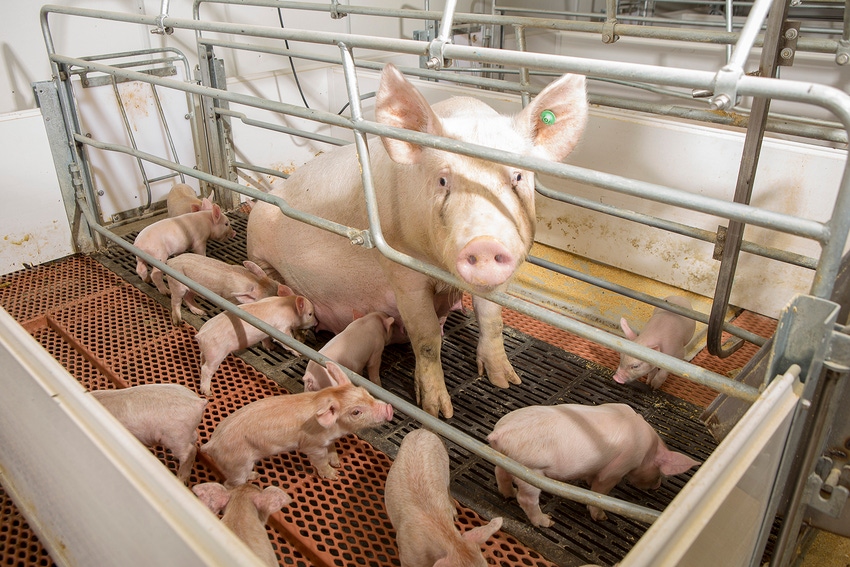Next level precision sow feeding
Research has demonstrated that feeding frequency impacts metabolism and, consequently, dietary nutrient requirements.
March 21, 2019

By Ryan Samuel, South Dakota State University
As the nutritional requirements of sows continue to be further refined, are there opportunities to achieve next level precision sow feeding? Traditionally, sows have been fed once per day, which has been shown to increase the efficiency of energy utilization, but decrease the efficiency of protein utilization. There may exist a trio of “rights” in precision feeding modern, prolific sows — the right diet, in the right quantity, at the right time.
Work is ongoing at South Dakota State University that will better define the right diet and the right quantity with respect to dietary amino acid requirements and phase or transition feeding sows over multiple parities. Unfortunately, there appears to be a dearth of recent information on feeding sows at the right time and the importance in achieving next level precision sow feeding.
Previous research has not demonstrated any significant advantage in productivity to feeding sows more than once per day. For example, it has been observed that pigs fed a single meal gained weight at a similar rate as pigs fed frequent small meals (Allee et al., 1972). In fact, feeding sows once per day appeared to result in greater efficiency of energy storage compared to sows fed more than a single meal per day, according to Fabry (1969).
On the one hand, the improvement in energy utilization efficiency has also been attributed to reduced energy expenditure related to consuming a single meal compared to multiple meals (Baird, 1970). On the other hand, reducing feeding frequency has an effect on lipid metabolism. As an adaptive mechanism for storage of large energy intakes, lipogenesis is stimulated by infrequent meal feeding (Leveille and Hanson, 1965). The result of increased lipogenesis is increased body fat and plasma lipid concentrations (Fabry, 1969). Whereas single-meal fed animals tend to retain excess energy primarily as fat, frequently-fed animals tend to store excess carbohydrates as glycogen, rather than converting them to lipid (Leveille and Hanson, 1965). As a result, it can be predicted that the composition of the body weight gain between frequently-fed and single-fed animals would be different. Therefore, the effect of meal feeding on energy metabolism should be considered for the impact on sow dietary requirements and body composition.
Animals fed once per day appear to retain more energy as fat, compared to animals consuming meals that are more frequent. However, animals fed once per day appear to oxidize more amino acids due to the inability to deal with the large influx of nutrients (Fabry, 1969). Work conducted at the University of Alberta investigated the energy and protein metabolism of non-pregnant sows and pregnant sows through gestation. Simultaneous measurements of energy, using open circuit calorimetry, and protein metabolism, as whole-body protein turnover, demonstrated that the periodicity of eating had opposite impacts on sow metabolism.
Therefore, while single-meal feeding improved the efficiency of energy retention, the efficiency of protein utilization was reduced in those sows (Samuel, 2008). Recently, the University of Minnesota reported that when sows were fed in the afternoon, instead of the morning, alterations in energy and nutrient metabolism improved backfat gain (Manu et al., 2019).
A goal within agriculture and, therefore, the swine industry, is to achieve precision feeding. One of the objectives in this vein is lowering the crude protein content of swine diets. Potential advantages of low crude protein diets include savings on expensive protein ingredients, thereby reducing diet costs, reductions in nitrogen emissions, thereby reducing the impact on the environment, and improvements in gut health, thereby improving the production efficiency. However, the results of feeding sows diets with low crude protein formulations have been mixed (McMillan, 2003). Perhaps the dietary requirements for amino acids are greater due to single-meal feeding, where protein utilization is reduced, than if sows were fed more frequent, smaller meals.
Furthermore, reductions in dietary crude protein content will require greater levels and mixtures of synthetic amino acids in the diets. Therefore, the potential for infrequent feeding to negatively impact amino acid utilization due to nutrient asynchrony may increase. Amino acid asynchrony refers to the delayed digestion and absorption of protein-bound amino acids compared to synthetic amino acid sources. Therefore, what are the potential implications of increasing the inclusion of synthetic amino acids, such as within lower crude protein diets, and single-meal feeding?
Within one gestation cycle, feeding sows more than once per day has not been shown to provide an advantage in measures of sow productivity such as the number of pigs born, born alive, strength of the piglets, or daily feed cost per sow (Baird, 1970). However, research has demonstrated that feeding frequency impacts metabolism and, consequently, dietary nutrient requirements (Le Naou et al., 2014). Ideally sows are not kept in the breeding herd for a single gestation; therefore, it is imperative that sow research be carried out over at least two parities. Because there is limited new research on the topic, in order to achieve next level precision sow feeding, the effects of frequency of feeding and time of day of feeding on energy and protein requirements should be considered, especially when using a low dietary protein strategy.
References
Allee, G. L., D. R. Romsos, G. A. Leveille, and D. H. Baker. 1972. Metabolic adaptation induced by meal-eating in the pig. J. Nutr. 102: 1115-1122.
Baird, D. M. 1970. Individual and “skip-day” vs. group feeding systems for sows during gestation. Research Report 82 ed. College of Agriculture Experiment Stations, University of Georgia.
Fabry, P. 1969. Feeding pattern and nutritional adaptations. London, Butterworths.
Leveille, G. A., and R. W. Hanson. 1965. Influence of periodicity of eating on adipose tissue metabolism in the rat. Can. J. Physiol. Pharmacol. 43: 857-868.
Le Naou, T., N. Le Floc’h, I. Louveau, J. van Milgen, and F. Gondret. 2014. Meal frequency changes the basal and time-course profiles of plasma nutrient concentrations and affects feed efficiency in young growing pigs. J. Anim. Sci. 92: 2008–2016.
Manu, H., S. H. Lee, P. Ren, D. Pangeni, X. Yang, and S. K. Baidoo. 2019. Effects of time of feeding during gestation on sow’s performance. J. Anim. Sci. 97: 1234–1241.
McMillan, D. J. 2003. Development of Low Protein Diets for Sows: Effect on Performance and Energy Metabolism. MSc Thesis, University of Alberta.
Samuel, R. S. 2008. Maintenance energy metabolism in non-pregnant and pregnant sows. MSc thesis, University of Alberta.
Source: Ryan Samuel, South Dakota State University, which is solely responsible for the information provided, and wholly owns the information. Informa Business Media and all its subsidiaries are not responsible for any of the content contained in this information asset.
You May Also Like



